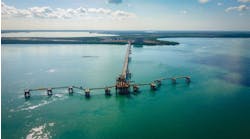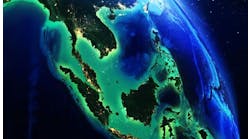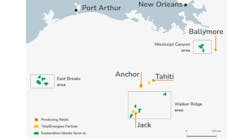Victor Schmidt • Houston
New exploration
The new exploration is exploitation. While the proportion of E&P capex has remained at around 15% of most companies' budgets, a larger proportion of the available money has been supporting production activities. Most reservoirs leave from 40-60% of the original oil-in-place in the reservoir after primary production. Reaching the remaining reserves requires more drilling and investment, but at a lower risk than wildcat exploration. Oil companies like lower risk.
Much of the effort and service company promotion at the SPE convention, recently held in Houston, Texas, was aimed at this expanding segment of the E&P market. Precision Drilling announced their re-branding effort to address the market for multi-well projects in mature fields. Much of the wider effort is devoted to onshore fields, but the offshore sector is a potential market for this activity as well. Extracting the left-behind oil in deepwater reservoirs will test the industry's ability in technology and cost control like no other projects yet undertaken.
Full-wave, fiber-optic JIP
QinetiQ and Input/Output have begun a joint industry project (JIP) to develop and deploy the world's first fiber optic seabed seismic acquisition system to acquire full-wave seismic data from the seabed. The JIP is co-sponsored and funded by BP, ChevronTexaco, ConocoPhillips, and Shell.
The fiber optic seabed system being developed will be fully optical, with no in-water electronic components. This is designed to increase system reliability and reduce life-cycle ownership costs compared to conventional, cable-based systems.
"The systems for time-lapse, seismic permanent monitoring are still relatively immature by oil industry standards," said Tim Jackson, Multicomponent Seismic Technol-ogy program manager at BP, speaking on behalf of the JIP participants. "Most, however, share a similar design based on ocean-bottom cables and geophone sensors, which can be costly both to deploy and to maintain. We think full-wave (multi-component) fiber optic systems could provide the cost breakthrough required to accelerate the adoption of permanent reservoir monitoring systems in the marine environment." According to Michael Gill, QinetiQ's Fiber Optic Business Group manager, Phase 1 of the development program will assemble and deploy a prototype system by the end of 2004.
TECHNOLOGY
Communications
Schlumberger Information Solutions (SIS) has expanded its satellite services offerings with IPerformer and IPresence services for Internet Protocol over Very Small Aperture Terminal (IPoVSAT).
IPerformer offers a dedicated, flexible network that can be tailored to business needs. IPresence allows clients to share satellite bandwidth and terrestrial infrastructure securely and efficiently with minimal capital outlay.
Cross-software environment
ESSS and CEI have released Cyclops, software for integrating, manipulating, and visualizing geology and reservoir engineering data sets in a single environment. ESSS (Engineering Simulation and Scientific Software), a Brazilian company, developed Cyclops and is marketing and selling in partnership with CEI.
null
Cyclops can handle geologic and reservoir data, including structured, unstructured, and reservoir grids, with scalar and vector variables associated to cell centers, faces, edges, or nodes. Well data from simulation or measurement can be loaded in the same environment, allowing users to analyze both simultaneously.
EXPLORATION
Namibia
Veritas recently hosted seminars in Houston for the 4th Namibian Licensing Round. Some 25 companies attended to hear presentations on this under-explored area. The seminars were attended by the Hon. Nickey Iyambo, Namibian Minister for Mines & Energy; Joe Vatanavi Mazeingo, managing director of National Petroleum Corp. of Namibia (Namcor), and other senior government and Namcor officials.
The License Round runs through Jan. 31, 2005, and covers selected blocks in the Orange and Walvis basins. Veritas acquired 3,300 km of long-offset 2D seismic data in 2003 to extend coverage over the Kudu trend to the south and to look at deeper water plays to the west. This data, together with reprocessed vintage data, is available as a package from Veritas, together with a comprehensive interpretation report.
null
A specific prospect, Ondjou (elephant in the Otjiherero language), has been identified by Namcor in the Walvis basin and is included in the licensing round. It is a giant structure previously mapped by Namcor and now confirmed by new seismic data.
New Zealand taxes
As part of a package of measures to boost gas exploration in New Zealand over the next five years, the government announced that it would legislate to remove a tax obstacle by temporarily lifting the "183-day rule" for offshore rig operators. The government is now extending the tax exemption to include development drilling and non-resident operators of seismic survey ships.
"These operators can face problems similar to those of rigs undertaking exploration work," Revenue Minister Dr. Michael Cullen says.
The change means that non-resident offshore rig operators and non-resident operators of seismic survey ships will be exempted from paying company tax on their profits in New Zealand from June 30 to Dec. 31, 2009. This is the same period applying to the gas exploration royalty incentives announced on June 14. The change will be included in a taxation bill to be introduced in November.





